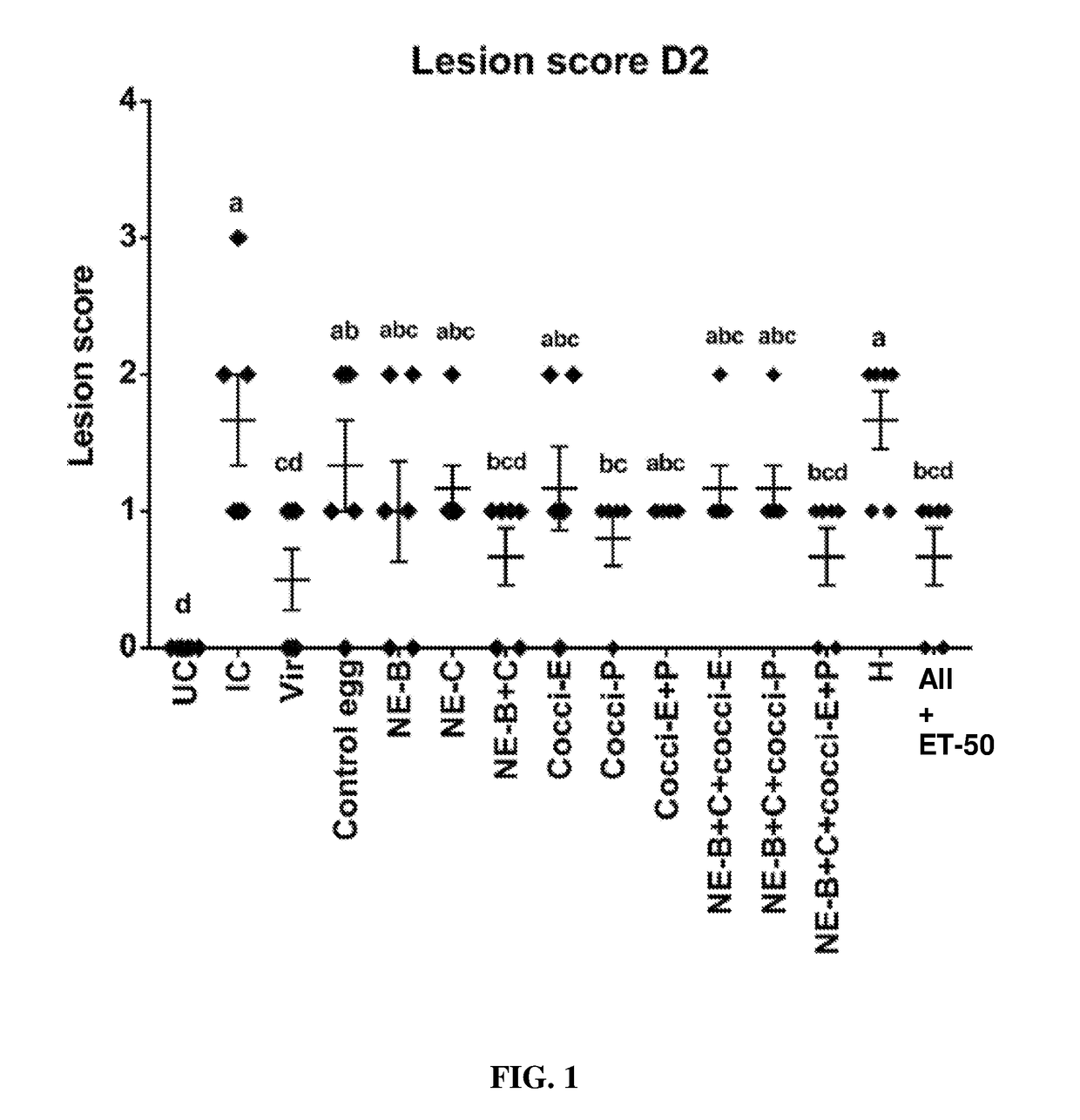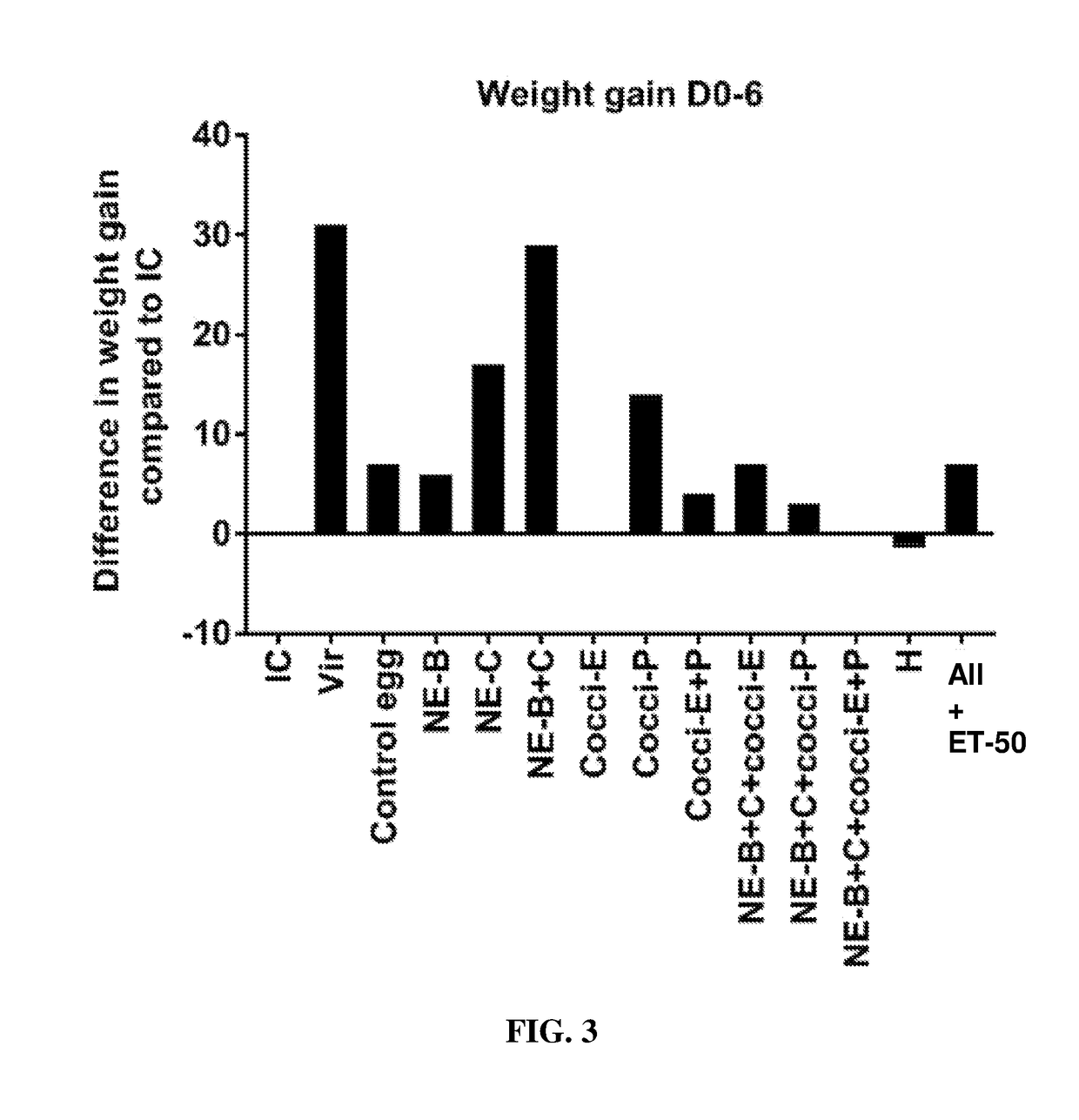Hyperimmunized egg product for treatment of necrotic enteritis in poultry
a technology of necrotic enteritis and hyperimmunization, which is applied in the direction of antibacterial agents, drug compositions, peptides, etc., can solve the problems of economic loss, increased incidence of necrotic enteritis, and severe economic losses
- Summary
- Abstract
- Description
- Claims
- Application Information
AI Technical Summary
Benefits of technology
Problems solved by technology
Method used
Image
Examples
example 1
on of Hyperimmunized Egg Products
Preparation of ET-50 Vaccine
[0144]A bacterial culture containing all of the bacteria shown in Table 1B above, as obtained from the American Type Culture Collection, was reconstituted with 15 mL of media and incubated overnight at 37° C. Once good growth was obtained, approximately one-half of the bacterial suspension was employed to inoculate one liter of broth with the inoculate being incubated at 37° C.
[0145]After good growth was visible in the culture, the bacterial cells were harvested by centrifugation of the suspension for 20 minutes to remove the media. The bacterial pellet obtained was resuspended in sterile saline solution and the bacterial sample was centrifuged three times to wash the media from the cells. After the third sterile saline wash, the bacterial pellet was resuspended in a small amount of double distilled water.
[0146]The media-free bacterial suspension was killed by placing the suspension in a glass flask in an 80 C water bath o...
example 4
nization of Laying Hens and Determination of IgY Titers
[0167]Cloning, Expression and Purification of Recombinant Clostridium perfringens Antigens for Hyperimmunization
[0168]The procedures for the production of recombinant proteins for immunization of hens followed ones previously described (Jang et al., 2012, Vaccine 30:5401-5406; Lee et al., 2011, Res. Vet. Sci. 91:e80-86). Briefly, full-length coding sequences of Clostridium perfringens α-toxin (Antigen A), NetB toxin (Antigen B), EF-Tu (Antigen C) and partial sequence of PFO (Antigen D) were cloned into the pET32a(+) vector with an NH2-terminal polyhistidine tag and transformed into Escherichia coli. Transformed E. coli DH5α bacteria were grown to mid-log phase (16 h at 37° C.), induced with 1.0 mM of isopropyl-β-d-thiogalactopyranoside (Amresco, Cleveland, Ohio) for 5 h at 37° C. The bacteria were then harvested by centrifugation and disrupted by sonication on ice (Misonix, Farmingdale, N.Y.). The supernatant was incubated with ...
experiment 1
s
[0185]Supplementation of diets with egg powder B or egg powder C protected birds from NE challenge as shown by the significant reduction in lesion scores following experimental NE challenge relative to birds on non-supplemented diets (FIG. 19).
Experiment 2—Body Weight Gain
[0186]The results looked similar to that of experiment 1 and the body weight gain of birds fed with egg powders B and C was significantly higher compared to those fed control egg powder. In fact body weight gain of birds fed egg powders B and C was equal to that of the control uninfected birds (FIG. 20).
PUM
| Property | Measurement | Unit |
|---|---|---|
| diameter | aaaaa | aaaaa |
| sizes | aaaaa | aaaaa |
| time | aaaaa | aaaaa |
Abstract
Description
Claims
Application Information
 Login to View More
Login to View More - R&D
- Intellectual Property
- Life Sciences
- Materials
- Tech Scout
- Unparalleled Data Quality
- Higher Quality Content
- 60% Fewer Hallucinations
Browse by: Latest US Patents, China's latest patents, Technical Efficacy Thesaurus, Application Domain, Technology Topic, Popular Technical Reports.
© 2025 PatSnap. All rights reserved.Legal|Privacy policy|Modern Slavery Act Transparency Statement|Sitemap|About US| Contact US: help@patsnap.com



